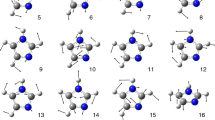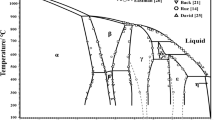Conclusions
-
1.
Complexation in the CuCl2-HCl-H2O system is studied at 77 K. Comopunds of composition [CuCl4(H2O)2]2−, [CuCl3(H2O)3 −, [CuCl2(H2O)4], [CuCl(H2O)5]+, and [Cu(H2O)6]2+ are shown to be formed depending on the ratio HCl-H2O. Parameters of the spin Hamiltonian of the EPR spectra are determined.
-
2.
The concentration dependence of the Cu(II) complexes which are formed in the HCl concentration range from 36 to 4% is obtained.
-
3.
A classical stepwise complexation process in this system is observed between HCl concentrations from 36 to 19%. Between 19-17% HCl, an unpredictable change of the relative concentrations of Cu(II) compounds occurs. Lowering of the HCl concentration from 17 to 4% gives rise to [CuCl3(H2O)3]−, [CuCl2(H2O-4], and [CuCl(H2O)5]+, the relative content of which remains constant.
Similar content being viewed by others
Literature cited
H. McDonnell and N. Davidson, J. Am. Chem. Soc.,72, No. 7, 3164 (1950).
B. Carlson and G. Wettermark, J. Inorg. Nucl. Chem.,38, No. 8, 1525 (1976).
J. Bjerrum and L. H. Skibsted, Acta Chem. Scand., Ser. A,31, No. 8, 5 (1977).
K. G. Ashurst and R. D. Hancock, J. Chem. Soc., Dalton Trans., No. 1, 245 (1981).
V. F. Plyusnin and O. M. Usov, Zh. Obshch. Khim.,55, No. 7, 1455 (1985).
A. Abragam and B. Bleaney, Electron Paramagnetic Resonance of Transition Ions, Clarendon Press, Oxford (1970).
N. N. Tikhomirova, K. I. Zamaraev, and V. M. Berdnikov, Zh. Strukt. Khim.,4, No. 3, 449 (1963).
W. B. Lewis, M. Alei, and L. O. Morgan, J. Chem. Phys.,45, No. 11, 4003 (1966).
G. M. Larin, Teor. Éksp. Khim., 4, No. 2, 244 (1968).
H. A. Kuska, M. T. Rogers, and R. E. Drullinger, J. Phys. Chem.,71, No. 1, 109 (1967).
V. V. Zhukov, Dissertation for the Degree of Candidate of Chemical Sciences, Inst. Geokhim. Analit. Khim. Akad. Nauk SSSR, Moscow (1976).
M. Sharnoff, J. Chem. Phys.,42, No. 10, 3383 (1965).
M. Sharnoff and C. W. Reimann, J. Chem. Phys.,43, No. 9, 2993 (1965).
R. Neiman and D. Kivelson, J. Chem. Phys.,35, No. 1, 156 (1961).
G. M. Larin, Zh. Strukt. Khim.,9, No. 6, 980 (1968).
S. V. Volkov, G. M. Larin, V. Ya. Zub, and E. A. Mazurenko, Koord. Khim.,9, No. 1, 26 (1983).
Author information
Authors and Affiliations
Additional information
Translated from Izvestiya Akademii Nauk SSSR, Seriya Khimicheskaya, No. 6, pp. 1223–1228, June, 1989.
Rights and permissions
About this article
Cite this article
Larin, G.M., Minin, V.V., Levin, B.V. et al. Complexation in the CuCl2-HCl-H2O system. Russ Chem Bull 38, 1111–1116 (1989). https://doi.org/10.1007/BF00957133
Received:
Issue Date:
DOI: https://doi.org/10.1007/BF00957133




